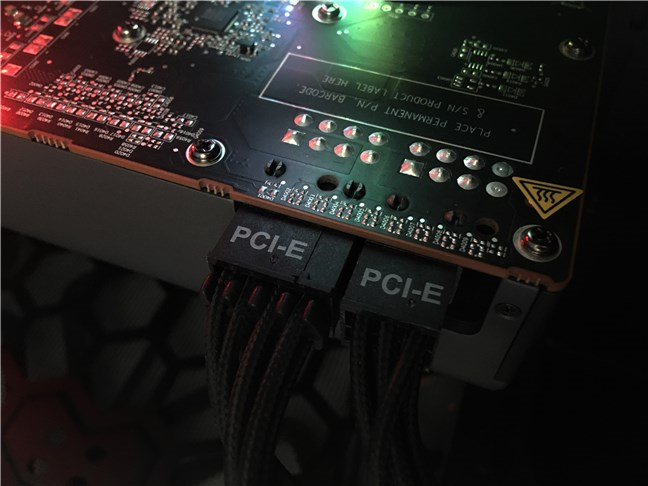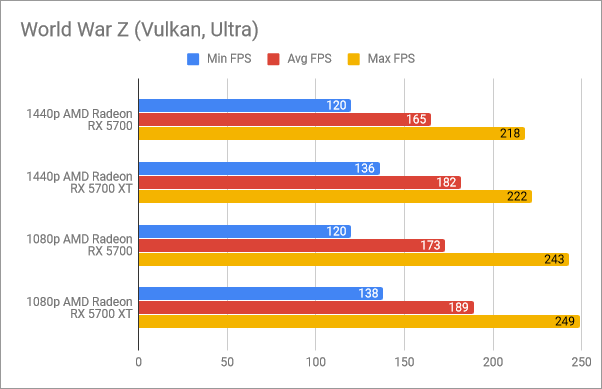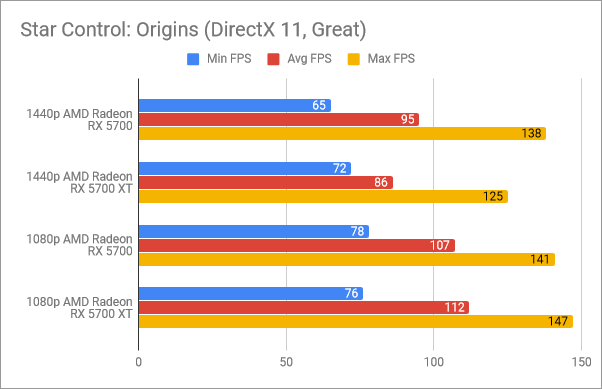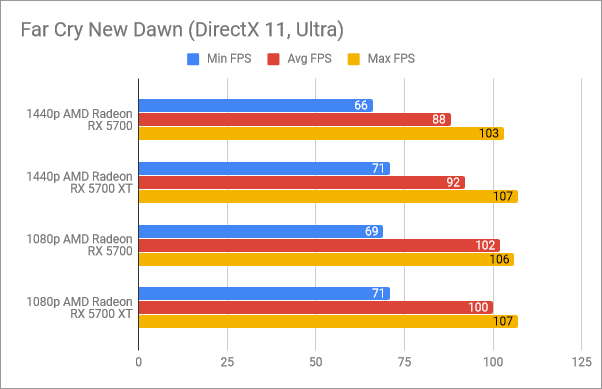
The Radeon RX 5700 is the smaller sister of AMD's family of new video cards. However, that is an understatement, as this graphics card packs a lot of processing power and, in many respects, it offers the same specifications as the RX 5700 XT. Built using the new RDNA architecture, on the new 7-nanometer manufacturing process, with 8 GB of GDDR6 RAM and support for PCI Express version 4, the Radeon 5700 is definitely prepared for the future. Are you curious to find more information about this graphics card? In this review, you can read about its features, design, and see how it fares in games and benchmarks:
AMD Radeon RX 5700: Who is it good for?
The AMD Radeon RX 5700 graphics card is a great choice for the gamers who:
- Play all the latest games, in 1440p or 1080p resolutions, in ultra-quality or at least with high quality details
- Want performance above the average, but are not prepared to pay high-end prices
- Want to pay less than what Nvidia asks for similar performance
Pros and cons
We have a lot of good things to say regarding the AMD Radeon RX 5700:
- In all the games and benchmarks that we used, the performance was solid
- The card is built on AMD's latest RDNA architecture, using the new 7 nm manufacturing process
- It comes with 8 GB of GDDR6 RAM, more than enough for gaming and VR experiences
- It is a better deal than what you get from Nvidia, in terms of price per performance
- It supports the new PCI Express version 4.0 standard
As for its downsides, there are a few to consider:
- The stock cooling system is pretty weak, and the card heats quite a lot
- It does not support ray tracing
Verdict
AMD Radeon RX 5700 is a great mid-range card. It is able to run almost all games in ultra-quality graphics details, both in 1440p and 1080p resolutions. The only game in which it did not quite manage to push beyond 60 frames per second, in ultra-quality graphics settings, was Metro: Exodus. At launch, for its price, the AMD Radeon RX 5700 does better than its competition. It is an excellent video card that we recommend to gamers who want great performance at a reasonable price.
Design and hardware specifications
The first thing you notice about the AMD Radeon RX 5700 graphics card is that it has a minimalist design. Its cooling system is plain and simple, featuring only a blower fan and the RADEON branding inscribed in red.
The AMD Radeon RX 5700 has no backplate, leaving the circuits board open and visible. It is not a design choice we like, but it is a clear message that AMD tried to make this video card as affordable as possible.
One of the reasons why AMD might have chosen to put only one fan on this video card is the fact that it should not get very hot. However, a single fan is not going to let you overclock the card. As you'll see later in this review, AMD Radeon RX 5700's top temperatures are not as low as you might want. If you are thinking about overclocking, you should probably wait for manufacturers such as ASUS, MSI, or Gigabyte, to release custom implementations of this video card, with better cooling systems.
Moving on to the hardware specifications, AMD created this video card as a solution for gamers who want to play games in 1440p or 1080p resolutions at ultra graphics quality. Although it comes at an affordable price, it is a mid-range video that can offer a lot of performance.
The Radeon RX 5700 graphics card uses AMD's latest architecture, called RDNA, and a 7-nanometer manufacturing process. In comparison, the AMD Vega cards are built on a 14-nanometer process, Nvidia's Turing cards are built on 12-nanometer and Pascal cards on 16-nanometer processes.
The RX 5700 video card has 36 compute units, is capable of computing 7.95 teraflops, and has 8GB of GDDR6 memory. Its base clock is 1.47 GHz, and its boost clock is 1.73 GHz. It also supports PCI Express 4.0, unlike all other video cards from AMD's previous generations or any of Nvidia's video cards. For your information, PCIe 4.0 offers double the bandwidth of PCIe 3.
The AMD Radeon RX 5700 comes with three DisplayPort 1.4 ports and one HDMI port that offers support for 4K resolutions at a refresh rate of 60 Hz.
This video card requires about 180 Watts to run and, according to AMD, a power supply unit of 600 Watts is recommended. To get its power, the video card has two additional power connectors: one with 8 pins, and one with 6 pins. It is also worth mentioning that the card does not offer support for AMD Crossfire, meaning that you can use no more than one video card on the same computer.
Regarding its physical dimensions, the Radeon RX 5700 is pretty large: it occupies two PCI Express slots and has a length of 10.55 inches or 268 mm.
If you want to see more information and all the details regarding its hardware specifications, visit AMD Radeon RX 5700.
The hardware specs of the AMD Radeon RX 5700 tell us that it's a bit slower than its big sister, the RX 5700 XT. However, this graphics card should theoretically run any modern games in 1080p and 1440p resolutions in ultra quality. What we do not like is the lack of a backplate and the cooling system, which could have been better.
Performance in games and benchmarks
More than just looking at its specs, we were intrigued to find out how the AMD Radeon RX 5700 graphics card fares in real life, so we used it to play a couple of games, as well as run a few benchmarks. Here's hardware and software that we used with it:
- Processor: AMD Ryzen 9 3900X (12 cores, 24 threads, Base Clock 3800 MHz, Max Boost Clock 4600 MHz)
- Motherboard: Gigabyte X570 AORUS MASTER
- Memory: G.Skill Trident Z Royal Memory (2 x 8GB, 3600MHz, PC4-28800)
- Storage: AORUS NVMe Gen4 2TB Solid State Drive
- Monitor: ASUS ROG Strix XG32VQ Curved Gaming Monitor (32-inch WQHD 2560 x 1440, 144Hz)
- Power Supply Unit: ASUS ROG Thor 850W Platinum
- Operating System: Windows 10 Pro x64 with May 2019 Update
To get a better idea of what the AMD Radeon RX 5700 offers, we compared it with its more expensive sister, the AMD Radeon RX 5700 XT, which costs 50 dollars more.
The first game that we tested with the AMD Radeon RX 5700 graphics card was World War Z. We configured the game to use the Vulkan API and the Ultra graphics quality settings. Running the game on the 2560 x 1440 resolution, we obtained a minimum of 120 frames per second (FPS), an average FPS of 165, and a maximum FPS of 218. While using the 1920 x 1080 resolution, the FPS minimum value was 120, the average FPS 173, and the maximum FPS 243.
In Star Control: Origins, a DirectX 11 game, we measured the FPS output while driving a lander on the Triton moon. The game was set to its highest graphics quality. On the 2560 x 1440 resolution, we saw a minimum FPS of 65, an average of 95, and a maximum of 138. In 1920 x 1080, we got 78 FPS minimum, 107 FPS average, and 141 FPS maximum.
Battlefield V is one of the games that require the most video processing power. For it, we chose to use the DirectX 12 API and the Ultra quality settings. In the 1440p resolution, the graphics card rendered a minimum FPS of 72, an average FPS of 95, and a maximum FPS of 106. In 1080p, the minimum FPS was 88, the average FPS 116, and the maximum FPS 153.
Far Cry New Dawn is a game that looks gorgeous, even if it uses DirectX 11 only. Using the game benchmarking tool at the 1440p resolution, we got a minimum of 66 FPS, 88 FPS on average, and 103 maximum. In 1080p, the video card rendered 69 FPS minimum, 102 FPS on average, and 106 FPS maximum.
Shadow of the Tomb Raider is one of the most beautiful games today, but it is also one of the games with the highest requirements. We tested it using DirectX 12 and the Highest graphics quality. Benchmarking the game in 1440p, we got a minimum FPS of 57, an average of 70, and a maximum of 108 FPS. In Full HD (1920 x 1080), the video card rendered 83 FPS minimum, 105 FPS on average, and 169 FPS maximum.
Tom Clancy's The Division 2 has a benchmarking tool that only tells the average FPS. Using DirectX 12 and the Ultra graphics quality preset, we got an average FPS of 59 on the 1440p resolution, and 88 FPS on the 1080p resolution.
Metro Exodus is one of the best games of 2019, but it is also probably the most demanding game of the year. With DirectX 12, the Ultra video preset, and a 1440p resolution, we managed to get a minimum of 22 FPS, an average of 50 FPS, and a maximum of 75 frames per second. On 1920 x 1080, the results were a bit better, but the minimum FPS was almost the same: 23 minimum, 60 average, 88 maximum.
In Fortnite, the popular battle-royale game, we set the Epic graphics settings and measured a minimum FPS of 41, an average of 87, and a maximum of 105 on the 1440p resolution. On 1080p, the card managed to render a minimum of 74 FPS, an average of 115 FPS, and a maximum of 156 FPS.
Apex Legends is also an online battle royale game. In 1440p and using the highest graphics settings, we saw a minimum of 58 FPS, an average of 70 FPS, and a maximum of 108 FPS. In 1920 x 1080, we had 82 FPS minimum, 105 FPS on average, and 144 FPS maximum. As you can notice, in Apex Legends, the maximum FPS doesn't get higher than 144. That is because the game caps its maximum frame rate at 144.
In the end, we also benchmarked the Radeon RX 5700 with a few specialized apps, from 3DMark and Unigine. In 3DMark's Time Spy (DirectX 12 and 2560 x 1440 pixels resolution), we got a score of 7812. In Unigine Superposition, using the 1080p Extreme graphics preset, we got a score of 4415 with DirectX 11 and 3679 with OpenGL.
While running the benchmarks, we also found out that the Radeon RX 5700 video card needs about 180 Watts of power. Finally, we checked how much the card heats while running 3DMark's Time Spy Stress Test. Unfortunately, the AMD Radeon RX 5700 gets quite hot: up to 83 degrees Celsius or about 182 degrees Fahrenheit.
The AMD Radeon RX 5700 is an excellent mid-range graphics card. It is hard to beat it at the price it's sold, considering that it can run any game in high or ultra quality at 60 FPS, both in 1440p and in 1080p.
What is your opinion about the AMD Radeon RX 5700?
These were our thoughts and opinions about the AMD Radeon RX 5700 graphics card. It is one of the best mid-range video cards right now, and Nvidia's products in this price range finally have a true competitor on the market. Before closing this review, tell us what you think about AMD Radeon RX 5700, in a comment below.


 22.07.2019
22.07.2019 





















